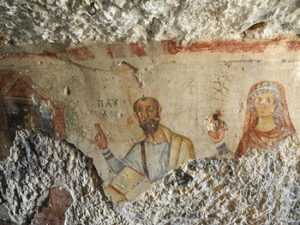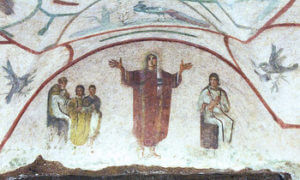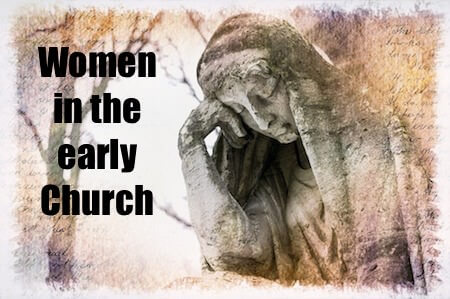When arguments are made against women preachers, people often cite lack of precedence – women have never been teachers within the church and therefore should not be now. Jesus called only called men to be his followers and to spread his message.
Evidence from the gospels
So what if it is actually quite easy to find evidence of women as teachers and having prominent positions within the early church? What does that do to our current perceptions of women in authoritative positions.
Even Paul who wrote the very earliest Christian texts that we have – the epistles, actually mentioned women who are teachers such as Priscilla. He even mentions a woman called Junia as being amongst the apostles although the interpretation of this passage has often been disputed. But there again he is also quoted as saying women should be quiet and obey their husbands, which is something that scholars think was inserted later. The two attitudes seem at odds.
Evidence from Apocrypha
Things become more confusing when you look outside the gospels to popular apocryphal tales such as Paul and Thecla which forms part of the Acts of Paul.

Image: Paul and Thecla fresco grotto, Epheshus. David Lull Creative Commons Flickr. Note how in this image Thecla’s face and teaching pose has been wiped out in an attempt to hide the fact she is a teacher.
This tells the tale of a young woman called Thecla who despite being engaged to be married, decides to renounce family life to go out and preach the new religion of Christianity having heard Paul preaching in her town. This causes great consternation because in the pagan world, women were meant to be daughters or wives and create families. There was no other lifestyle available to them.
This tale actually describes why Christianity took root with women; with its messages to turn away from family life and sexual procreation, it provided a radical path to freedom for women who would be otherwise tied to domesticity and baby rearing. For people of the pagan world who were centred around family, this was shocking.
The popularity with women was such that it caused the Roman commentator, Celsus to scoff at the fledging religion as one populated with ‘slaves and women’. In such comments we can get a glimpse of the ethos of equality that may have existed in early Christianity. This was a religion which didn’t care about your role in the physical world now, but in your spiritual role in the next world.
Christians today might find this shocking as they see the Church as family centred. But in the early days it was about keeping yourself free from the distractions and attachments of family life so you could devote yourself to the spiritual one in preparation for the End of the Age, which early Christians believed was happening very soon and within their own lifetimes.
The Cover up
Things changed of course and over time the early prominence that women played in the church has not only been forgotten, there are signs that it has been covered up.
One simple example is in Mary Magdalene. In three of the gospels she sees the risen Christ. If this is the definition of an apostle, she is an apostle. But she is hardly mentioned after this.
In fact, as Ann Graham Brock points out in her book, Mary Magdalene, ‘The first Apostle’, in the Gospel of Luke, Mary Magdalene’s role has been diminished and Peter rises to prominence. He is no longer the blunderer that Jesus even calls ‘Satan’ in Matthew’s Gospel when he admonishes Peter for valuing the world of men over God.
Peter is often portrayed as someone who just doesn’t get Jesus’ teachings. But in Luke’s Gospel Peter’s blunderbuss antics are played down and he is put in a more prominent position at the expense of Mary Magdalene.
Looking to extra canonical gospels again this replacement can be even more stark. The Acts of Phillip features a teacher and miracle worker, Mariamne who is thought to be Mary Magdalene in the Greek versions, but in later Coptic versions she is replaced by Peter! In some texts even in Mary Magdalene’s pivotal encounter at the tomb, she is replaced by Mary the Mother of Jesus.
So we have signs that any evidence of women holding high status in the early church has been diminished or even edited out.
Present day cover up

16724149006_3d12e5fecc_z-medium.jpg
Image: Flickr Creative commons attribution Steven Zucker https://www.flickr.com/photos/profzucker/
This even continues to the present day as in the case of the Catacombs of Priscilla in Rome. These recently rediscovered underground tombs are complete with paintings and frescoes dating from the 3rd Century CE that seem to depict women teachers and even women running a Eucharist meal. However, the idea that these frescoes depict women as teachers or holding any leadership roles were dismissed by the Vatican as pure fantasy.
Although the Vatican may indeed like to dismiss this concept as pure fantasy it is hardly an academic approach. The true approach to scholarship would be to examine the possibility that these early tomb painting indeed depicted women as teachers in the early church because there were actually women as teachers in the early church. I can’t help but look at the image of the women in the red outfit and think it might be referring to Mary Magdalene as she is traditionally clothed in red in art.
But this may be too early to make that connection and I also don’t know if I am looking at the original pigment. It may be completely wrong, but that is not the point. The point is that we should have at least a discussion. We should open up and revisit the issue of women in the early church in an age when at least some of us can look through a lens that does not contain the prejudices of the past.
And when we do, we may find more that we though possible that was staring at us all along about the status of women in the early church that we just were not able to see.
Lastly, you may enjoy this poem that came through me whilst researching this topic. I feel it came from the collective consciousness of the early women so long ignored by the male dominated church.
Women’s voices
we weep
as we sweep his feet with our hair
you leave us no choices
you take away our will to be
if we lose a man
we lose our right to live, to dignity
so we do what we can to survive
our only choices
yet still you denigrate us
as sinners
yet leave the ones who come to us
who pay to violate our bodies
in the most carnal ways
as sin free
somehow it is our fault
that we tempted them
and yet the the ones who comes to us with deliberation
are left without a blemish
and we are the ones who bear the stigma of sin
for centuries
and yet when there is one of us
who rises to the status of teacher
instead of celebrating her strength and wisdom
you wish to bring her too to the status of the fallen
like there is nothing less you can tolerate
expect your repugnance for our kind
so keep your false piety
that all you want is for women to rise above
it is you who are bringing them down
When will you follow the example of he whom you say that you follow
when he transcended the flesh and understood the true nature of who we really are
who looked beyond the assignments of gender and of physicality
to the spirit within
his is the example that you say that you follow
yet you still deny spirit to a whole half of us
saying that spirit does not dwell within our bodies which you see both as imperfect and to be desired
Maybe one day you will truly follow in his footsteps
And honour the love within
Main Image: Pixabay





Dr. Manjir, I was pleasantly surprised you tackled this topic. As you know, the three “Abrahamic” religions (Judaism, Islam and Christianity) in the form they have been handed down to us are strongly patriarchial. That said, I believe that a reintroduction of balance and a reconnection with the Divine Feminine are the only hope for these religions, and in fact, for our civilization.
Thank you, Gerome. It is indeed an important topic and it is in the context of the connection to Mary Magdalene that has been coming to me since 2001. Check out the relevant pages on this website. Thanks for dropping by.